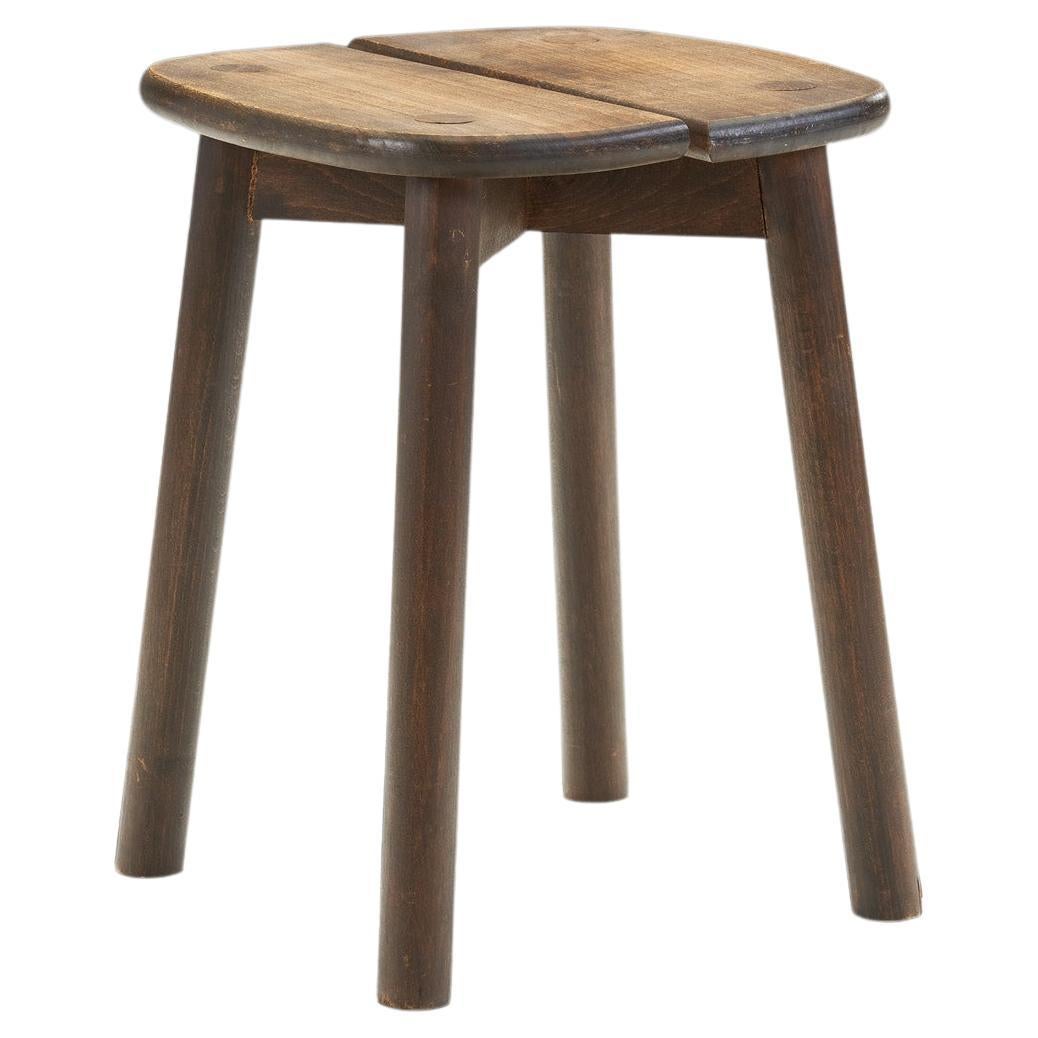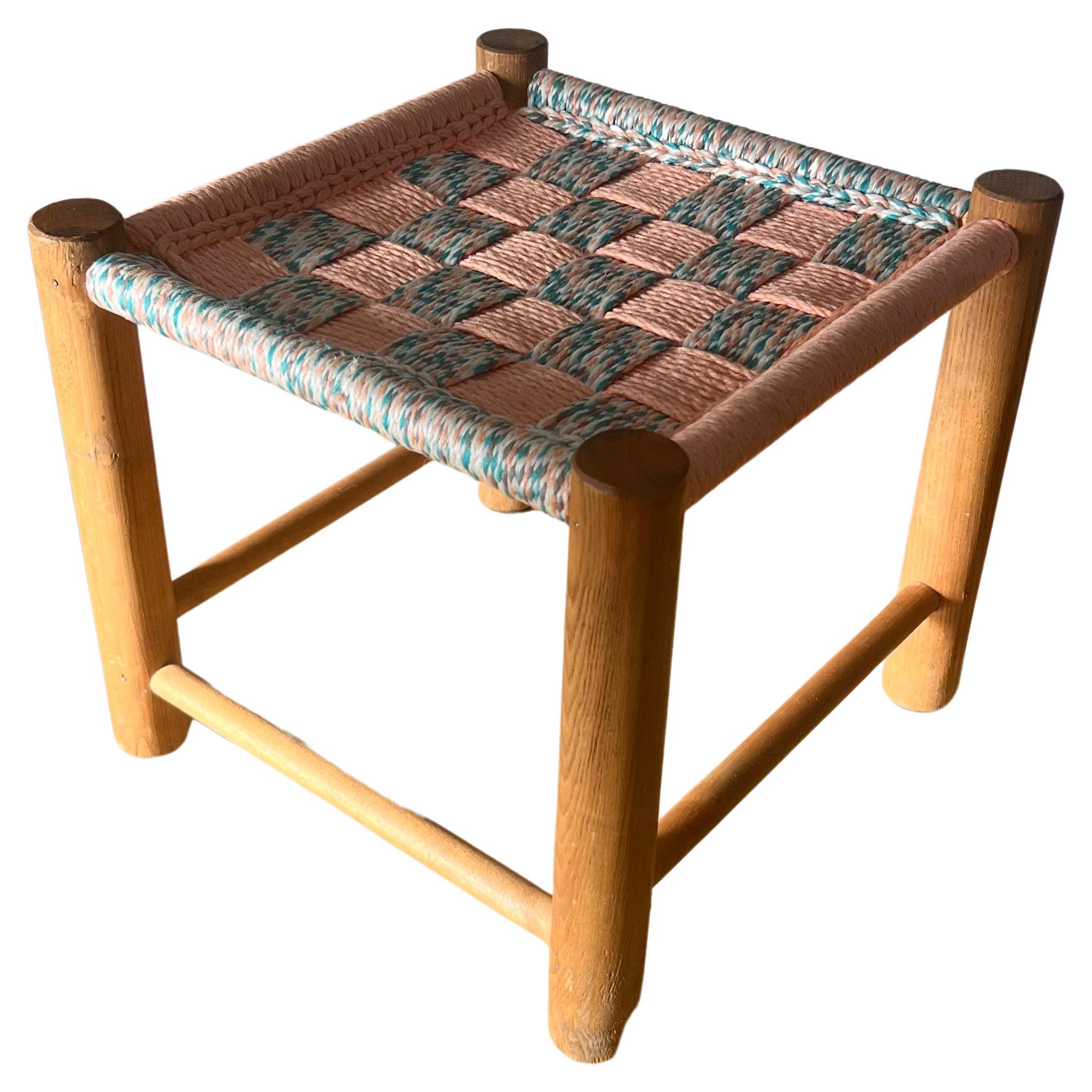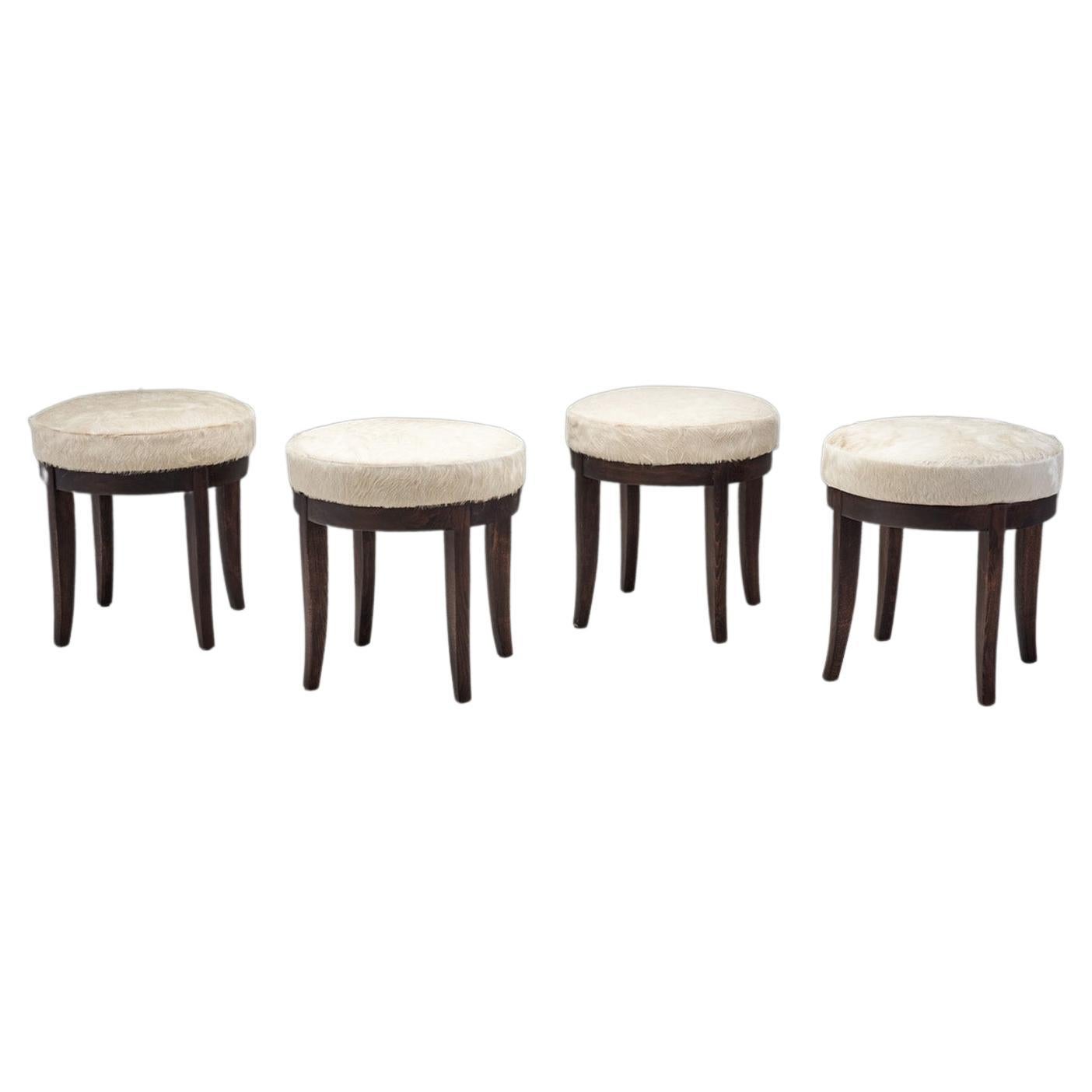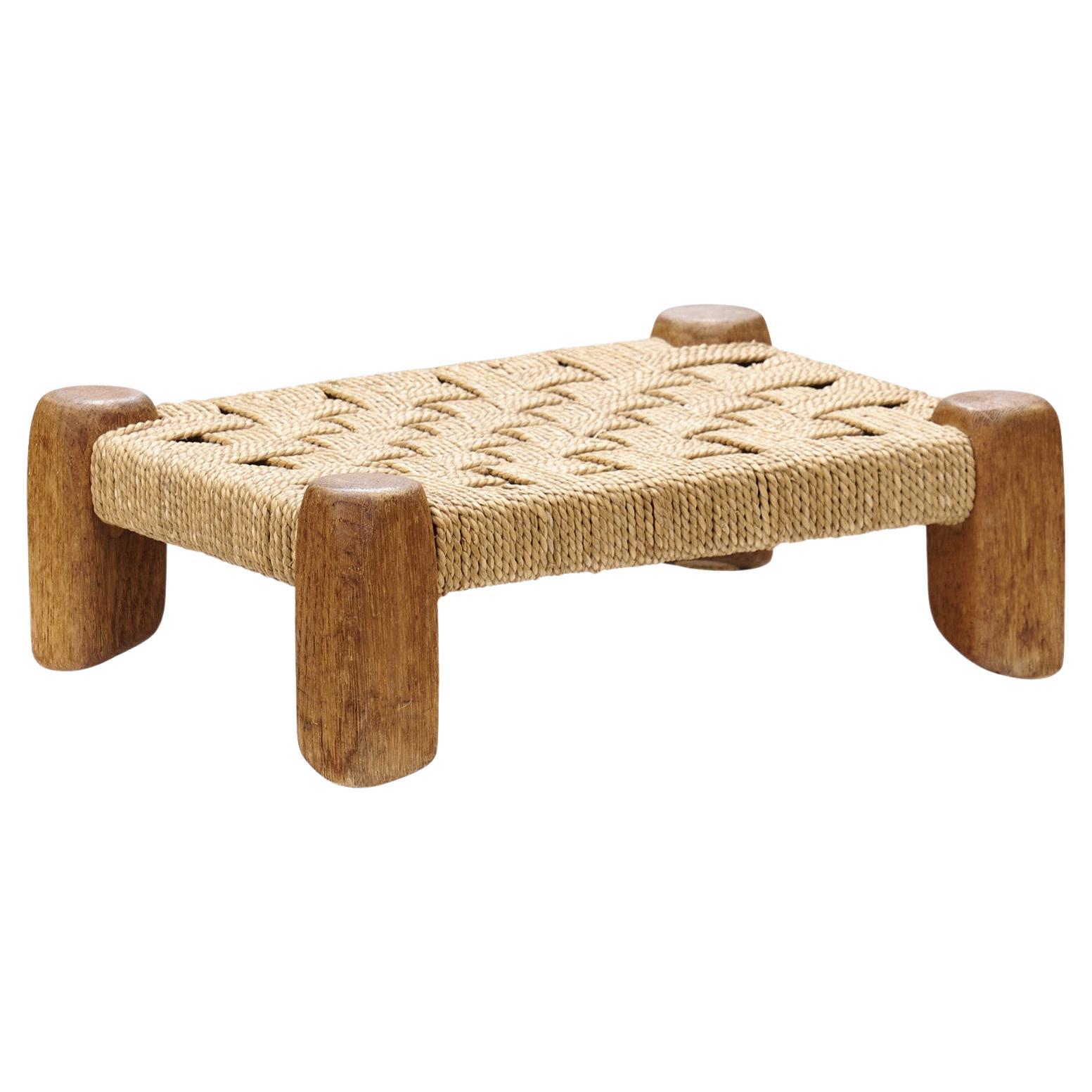Items Similar to European Mid-Century Wooden Stools with Hand-Carved Scoop Seats, Europe ca 1950s
Want more images or videos?
Request additional images or videos from the seller
1 of 6
European Mid-Century Wooden Stools with Hand-Carved Scoop Seats, Europe ca 1950s
About the Item
The design of this European stool is characterized by a minimal, clean approach that seeks to combine functionality with beauty. Its focus is on simple lines and light spaces, devoid of clutter. Accordingly, form and function collide in this stool. From Charlotte Perriand to Axel Einar Hjorth, wooden stools have been staples in European design history.
With a highly functional history and modernist look, this stool is a stylish piece. The seat has a very simple, circular shape, which is supported by three legs that widen towards the end. The edges are rounded, resulting in an aesthetic that is typical of the mid-century era. The round shape also complements the visually arresting pattern of the wood, especially on the seat, where the grain immediately stands out. This stool shares visual characteristics with modernism: it entirely focuses on its solid wood material and well-crafted, but simple lines. There was evidently a lot of care put into the construction; the joinery is seamless, and the surfaces are very smooth even on the legs. The maker of this stool not only had a preference for its main characteristics and material, but a deep respect as well.
The functionality, longevity and clean lines of this solid wood stool are all in favour of the user, maintaining the focus on authentic simplicity. The appreciation of rustic simplicity and craftsmanship has never completely gone out of style, but in recent years, it saw an increase. Adding organic pieces, like this stool to a modern interior can create a diverse and interesting aesthetic with just one item.
- Dimensions:Height: 14.18 in (36 cm)Width: 15.36 in (39 cm)Depth: 14.18 in (36 cm)Seat Height: 14.18 in (36 cm)
- Sold As:Set of 2
- Style:Folk Art (In the Style Of)
- Materials and Techniques:
- Place of Origin:
- Period:
- Date of Manufacture:1950s
- Condition:Refinished. Wear consistent with age and use. In good vintage condition. Wear consistent with age and use. Some marks and scratches on the wood. The carved seats have strong patina, but the weather casued stains on the seats have been cleaned.
- Seller Location:Budapest, HU
- Reference Number:1stDibs: LU9486237546542
About the Seller
New to 1stDibs
Joined in the past six months.
No Reviews Yet
Vetted Seller
These experienced sellers undergo a comprehensive evaluation by our team of in-house experts.
1stDibs seller since 2023
- ShippingRetrieving quote...Ships From: Budapest, Hungary
- Return PolicyA return for this item may be initiated within 14 days of delivery.
More From This SellerView All
- VEB Leuchtenbau Model "7204" Table Lamp, Germany 1950sBy VEB LeuchtenLocated in Budapest, HUThe "7204" lamp designed in the late 1950s at VEB Leuchtenbau is a classic example of mid-20th-century German design and craftsmanship. Manufactured by...Category
Vintage 1950s German Mid-Century Modern Table Lamps
MaterialsMetal, Brass
- Danish Cabinetmaker Triangular Coffee Table With Tapered Tripod Legs, Denmark caLocated in Budapest, HUassociate Danish furniture design with the country’s golden age, the mid-twentieth century. This simple, yet beautifully designed and executed side table shows why this is. This mid...Category
Vintage 1960s Danish Mid-Century Modern Side Tables
MaterialsWood
- Lívia Gorka Decorative Ceramic Bowl, Hungary ca 1960sBy Livia GorkaLocated in Budapest, HUMunkácsy Mihály Prize-winning Hungarian ceramicist, worthy artist, and daughter of Géza Gorka, Gorka Lívia is one of the most renowned Hungarian ceramists. Her present work is a highly distinctive piece even if measured against her own exceptional repertoire. In 1947, Lívia Gorka passed her master's exam in pottery. Her master was his father, Géza Gorka. As an independent, self-employed artist, se worked in the Gorka workshop in Verőce until 1959, and had created in her own studio after that. The source of her art has always been nature, and as such, her typical objects (if we can discuss typical at all in her case) are large, asymmetrical vessels, idols, fish, birds, and stones. Gorka preferred creating unique objects and to think in series and groups of objects. She worked with high-fired, custom-made materials such as stone, oxide clay glazes, and often combined clay with metal. The colours of her works have a strong plastic effect and are generally quite restrained. This handmade piece reflects her minimalistic and timeless language of forms that appears in every inch of this bowl that is in the field between art, design, and handicraft. The colours are spectacular, the black glazed outside harbours a medley of shapes and colours on the inside. This glazed, geometrically decorated piece has an unusual, modern shape with a hollow opening on top. The bright orange line traces the shape to the hollow opening towards the top and articulates the unusual angle at which the bowl stands. Lívia Gorka was able to step out of her father's shadow and create her own style with her ceramics. A true artist who always worked with craft techniques, she also developed her own technique for making the glaze, so her works, like this bowl, always represent a recognizable, unique world of shapes and colours. Gorka was a master of these subtleties that established her one-of-a-kind visual language that is still coveted not just in her native Hungary, but all around the world among ceramic enthusiasts and collectors. Thanks to this, it can easily be placed in both a vintage or contemporary interior and is sure to stand out from its surroundings. About the designer: Gorka Lívia (Nógrádverőce March 5, 1925 – Diszel, August 4, 2011) Mihály Munkácsy Prize-winning Hungarian ceramicist, a distinguished artist. Daughter of Géza Gorka. She was born in Nógrádverőce to Géza Gorka and Irén Kovács. She received her professional and artistic training in her father's workshop. She got used to serious work when he was six or eight years old, as she worked in his father's workshop during school breaks...Category
Vintage 1960s Hungarian Mid-Century Modern Ceramics
MaterialsCeramic
- "960 Tuoli" Modern Chaise Lounge by Antti Nurmesniemi for Cassina, Finland 1980sLocated in Budapest, HUThe Finnish interior designer, Antti Nurmesniemi (1927-2003) is considered one of the pioneers of the Finnish design industry. Nurmesniemi's present "960 TUOLI" chaise lounge, which ...Category
Vintage 1980s Finnish Modern Chaise Longues
MaterialsSteel
- Adrian Pearsall "2315-C" Lounge Chairs for Craft Associates, USA 1960sBy Adrian PearsallLocated in Budapest, HUAdrian Pearsall was born in 1925 in Trumansburg, New York. Like many Mid-Century Modern artists of the time, Pearsall was a graduate of architecture school. This background is profou...Category
Vintage 1960s American Mid-Century Modern Lounge Chairs
MaterialsBouclé, Wood
- Mario Bellini "Forma" Cantilever Armchair for Vitra, Italy 1990sBy Mario BelliniLocated in Budapest, HUThe now historic story goes: “About 20 years ago Rolf Fehlbaum, the Chairman of Vitra, called me up and said: The things we’re making are too boring. We want to change that, and you...Category
1990s Italian Modern Armchairs
MaterialsMetal
You May Also Like
- Mid-Century Wooden Stool with Split Seat, Europe Ca 1950sLocated in Utrecht, NLStools have been steadily increasing in popularity thanks to a number of reasons, the most obvious being their space-saving functionality. Stools can be used in any space to provide an easily moved alternative to more cumbersome furniture. However, thanks to their versatility, they can provide a lot of visual interest. European mid-century design is generally characterized by a minimal, clean approach that seeks to combine functionality with beauty. With its focus is on simple lines and light spaces, this stool is devoid of clutter. Standing on four straight legs, the sole decorative element is the split seat...Category
Vintage 1950s European Mid-Century Modern Stools
MaterialsWood
- Mid-Century Italian wooden stool, velvet seat. 1950sLocated in Argelato, BOMid-Century Italian wooden stool, velvet seat. 1950sCategory
Vintage 1950s Italian Mid-Century Modern Stools
MaterialsVelvet, Wood
- Mid century modern Perriand style wooden stool with woven seat, 1950sBy Charlotte PerriandLocated in View Park, CAA small wooden stool with a woven seat, circa 1950s. Yarn is tones of turquoise, coral, cream, and charcoal. Legs have felted bases. West includes some signs of age on the wood. Pick...Category
Mid-20th Century Mid-Century Modern Stools
MaterialsYarn, Wood
- Mid-Century Modern Set of Four Stools in Cowhide, Europe, ca 1950sLocated in Utrecht, NLMost of Europe has a long history of furniture-making. Through the 19th century, the country also had a very strong tradition of cabinetmaking, or producing traditional furniture by ...Category
Vintage 1950s European Mid-Century Modern Stools
MaterialsCowhide, Wood
- Woven Rush and Wood Stool, Europe ca 1950sLocated in Utrecht, NLFrom Charlotte Perriand to Axel Einar Hjorth, stools have been staples in European design history. Modernist stools, like this organic model, stem from one of the earliest forms of s...Category
Vintage 1950s European Mid-Century Modern Stools
MaterialsRush, Wood
- Mid-Century Wooden Stool, 1950'sLocated in Praha, CZ- made in Czechoslovakia - made of wood - with patina - good, original condition.Category
Vintage 1950s Czech Mid-Century Modern Stools
MaterialsWood
Recently Viewed
View AllMore Ways To Browse
Round Midcentury Stools
Vintage Rustic Wooden Stool
Painted Animal Brass
Black Woven Stool
15 Inch Stool
Small Stool With Back
Screw Bar Stool
Kitchen Countertop Stools
Cantilevered Work Bench
Ikea Wood Stool
Chinese Black Lacquered Stool
Wooden Stools With Three Legs
Ww Counter
Pair Of Upholstered Foot Stools
Johansson Gurli
Collapsable Stool
Charlotte Perriand Step Stool
Slim Barstool





